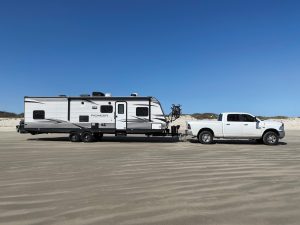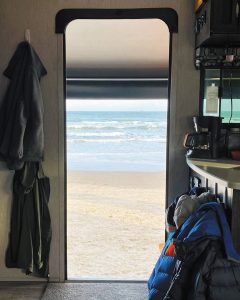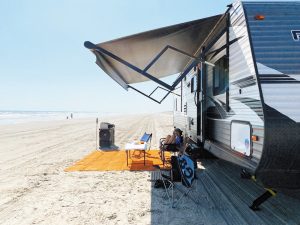Camping on the beach can be an adventure of a lifetime. These simple tips can make the beach the best campground ever.
By Abigail Epperson, F488212
July 2021
This winter, while traveling through Texas, our family took on an adventure we had never tackled in our nearly five years of full-time RV travel: beach camping. I’m not talking camping near a beach, with hookups and other amenities; I’m talking boondocking right on the beach, with the sea breeze filling our RV and ocean waves lapping at our front door. What we learned almost immediately is that with a little preparation and a positive attitude, almost any RVer can enjoy beach camping. No massive boondocking setup is required.

The first rule of beach camping with an RV is to make sure you don’t get stuck in the sand.
If you’re looking to expand your camping horizons and beach camping has been on your mind, here are eight tips to encourage you to get out there and enjoy a truly unique experience.
1. Know your RV’s limitations, and the beach conditions. Don’t get out on the beach if you’re not 100 percent confident you can get yourself off the beach. We camped with a Heartland Pioneer QB300 travel trailer pulled by a Ram 2500 pickup truck, so we knew we had the power to get our RV off the beach should we find ourselves stuck. That said, we did scout the area before we ventured out there. Mustang Island State Park, where we stayed, also has a campground with water and electric hookups, so we booked a few days there first, drove the beach, and scouted where we believed would be the safest place to camp. If you can reserve a few days at a campground near where you want to beach camp, we highly recommend doing so. If that’s not possible, make sure you park on compacted sand, and keep an eye on the tide (more on that in a minute). Again, do not go out on the beach if you are unsure you can drive yourself off. The last thing you want is an expensive tow back to solid ground.
2. Keep food simple, and cook outdoors. Leave the big, time-consuming meals for another day. This is beach camping, and beach camping is all about chilling out and enjoying the view. We did 90 percent of our cooking on our 17-inch Blackstone griddle, which sat on top of our SylvanSport Dine O Mite camp kitchen, and we kept it easy — taco bar with all the fixings one night; pancakes with bacon the next (because breakfast for dinner means you can add on Bloody Marys). Other easy meals can be a build-your-own sub sandwich bar with premade potato salad, fruit, chips, etc. Or enjoy some good old hot dogs and hamburgers — but save yourself the prep work by buying premade patties. The goal is easy and outdoors. Not only does outdoor cooking provide an incredible view, but it also helps keep temperatures down in your RV and makes clean-up a breeze.

Know how far the water comes up the beach at high tide, or you may step out the door and straight into the ocean.
3. An outdoor shower is your friend. Seriously, sand will be everywhere. Embrace it, but also have a plan to clean it off before you go inside. Our outdoor shower probably got more use that weekend than ever. Everything gets sandy, so rinsing off outside helps control what’s tracked inside. Just remember to conserve water, especially if you have a smaller fresh-water tank and plan on being there for more than a couple days.
4. Sunblock it up. Winter beach camping in Texas offers near-perfect weather conditions, but don’t be fooled by those comfortable temperatures. You need sunblock, and you need a hat. A waterproof sunblock with a high SPF is your best option. A hat you can secure to your head so it doesn’t blow off keeps you from having to take unwanted jogs down the beach, or worse, an unwanted swim in the Gulf of Mexico to retrieve it. Much the same goes for beach camping in other seasons.
5. Pay attention to the tide line when selecting a site. Find out what time you can expect high tide, and what direction the wind is expected to blow during your stay. You don’t want to find yourself in a situation where your RV is threatening to take a swim out to sea. Websites such as Tideschart.com show you when to expect high and low tide, and apps such as The Weather Channel give you wind predictions.
6. Bring a mat that repels sand. You’ll be glad for the sand-free space. We love our CGear sand-free mat, and we set it up right next to our door, under our awning. It makes for a great place to escape the sun, to enjoy those easy meals, and to take a break from all things sand.
7. You don’t need fancy gadgets to do this for a couple of days. I promise you, you don’t! We had no solar panels and no generator. We survived the weekend with only two regular ol’ batteries, a 40-gallon fresh-water tank, propane for cooking and keeping the refrigerator cold, and some solar lanterns. When we left after 48 hours on the beach, our fresh-water tank was empty, but our batteries were still two-thirds full. If we can do it with just a few simple items, anyone can!
8.Wash your RV right after. This is important. You need to get all the salt off your motorhome or truck/trailer so there’s no future damage or rusting caused by the delightful salt air.

With the right approach and a little preparation, camping on the beach can be so simple and relaxing it’s like, well, a day at the beach.
For $10 a night, you can camp right on the beach at Mustang Island State Park near Corpus Christi, Texas. Beach camping at the park is along a 1.5-mile stretch, with 50 undesignated sites that are filled on a first-come, first-served basis. Small campfires are allowed on the beach. If you’re wanting to try out the campground, which is about 400 yards away from the ocean and separated by a sand dune, reservations can be made through Reserve America; these sites cost $20 per night. We highly recommend staying at the campground first and scouting the beach camping locations while there.
Remember, beach camping doesn’t have to be a big gadget deal, and with a little prep beforehand, you can make it work, no matter your setup. This was a memory of a lifetime for our family, and I hope you, too, have the opportunity to enjoy the sand between your toes and a view out your front door you won’t soon forget.

